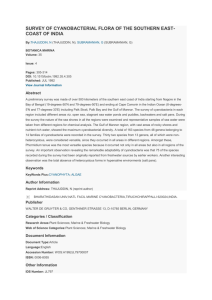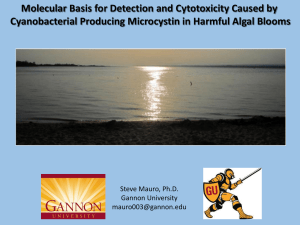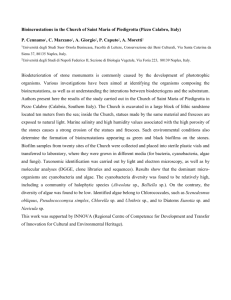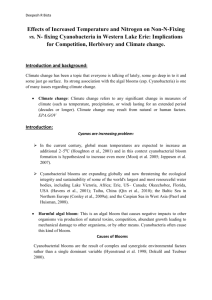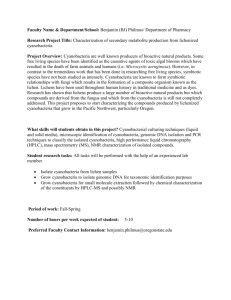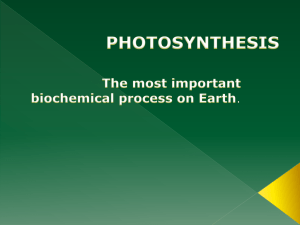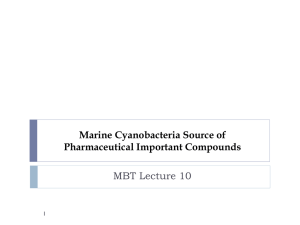T Algae and cyanobacteria in fresh water CHAPTER 8
advertisement
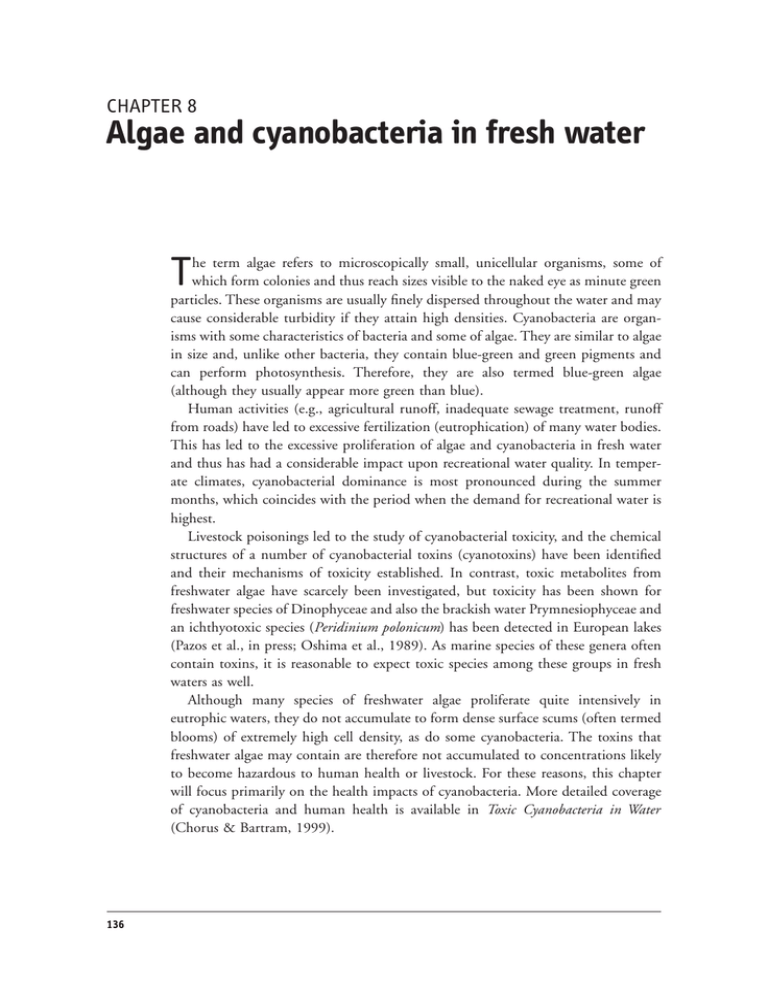
CHAPTER 8
Algae and cyanobacteria in fresh water
T
he term algae refers to microscopically small, unicellular organisms, some of
which form colonies and thus reach sizes visible to the naked eye as minute green
particles. These organisms are usually finely dispersed throughout the water and may
cause considerable turbidity if they attain high densities. Cyanobacteria are organisms with some characteristics of bacteria and some of algae. They are similar to algae
in size and, unlike other bacteria, they contain blue-green and green pigments and
can perform photosynthesis. Therefore, they are also termed blue-green algae
(although they usually appear more green than blue).
Human activities (e.g., agricultural runoff, inadequate sewage treatment, runoff
from roads) have led to excessive fertilization (eutrophication) of many water bodies.
This has led to the excessive proliferation of algae and cyanobacteria in fresh water
and thus has had a considerable impact upon recreational water quality. In temperate climates, cyanobacterial dominance is most pronounced during the summer
months, which coincides with the period when the demand for recreational water is
highest.
Livestock poisonings led to the study of cyanobacterial toxicity, and the chemical
structures of a number of cyanobacterial toxins (cyanotoxins) have been identified
and their mechanisms of toxicity established. In contrast, toxic metabolites from
freshwater algae have scarcely been investigated, but toxicity has been shown for
freshwater species of Dinophyceae and also the brackish water Prymnesiophyceae and
an ichthyotoxic species (Peridinium polonicum) has been detected in European lakes
(Pazos et al., in press; Oshima et al., 1989). As marine species of these genera often
contain toxins, it is reasonable to expect toxic species among these groups in fresh
waters as well.
Although many species of freshwater algae proliferate quite intensively in
eutrophic waters, they do not accumulate to form dense surface scums (often termed
blooms) of extremely high cell density, as do some cyanobacteria. The toxins that
freshwater algae may contain are therefore not accumulated to concentrations likely
to become hazardous to human health or livestock. For these reasons, this chapter
will focus primarily on the health impacts of cyanobacteria. More detailed coverage
of cyanobacteria and human health is available in Toxic Cyanobacteria in Water
(Chorus & Bartram, 1999).
136
8.1 Occurrence of toxic cyanobacteria
Toxic cyanobacteria are found worldwide in inland and coastal water environments.
At least 46 species have been shown to cause toxic effects in vertebrates (Sivonen &
Jones, 1999). The most common toxic cyanobacteria in fresh water are Microcystis
spp., Cylindrospermopsis raciborskii, Planktothrix (syn. Oscillatoria) rubescens, Synechococcus spp., Planktothrix (syn. Oscillatoria) agardhii, Gloeotrichia spp., Anabaena
spp., Lyngbya spp., Aphanizomenon spp., Nostoc spp., some Oscillatoria spp.,
Schizothrix spp. and Synechocystis spp. Toxicity cannot be excluded for further species
and genera. As research broadens and covers more regions over the globe, additional
toxic species are likely to be found. Therefore, it is prudent to presume a toxic potential in any cyanobacterial population.
The most widespread cyanobacterial toxins are microcystins and neurotoxins (see
section 8.3). Some species contain neurotoxin and microcystin simultaneously. Field
populations of the most common bloom-forming genus, Microcystis, are almost
always toxic (Carmichael, 1995), but non-toxic strains do occur. Generally, toxicity
is not a trait specific for certain species; rather, most species comprise toxic and nontoxic strains. For microcystins, it has been shown that toxicity of a strain depends on
whether or not it contains the gene for microcystin production (Rouhiainen et al.,
1995; Dittmann et al., 1996) and that field populations are a mixture of both genotypes with and without this gene (Kurmayer et al., 2002). Experience with cyanobacterial cultures also shows that microcystin production is a fairly constant trait of a
given strain or genotype, only somewhat modified by environmental conditions (see
various contributions in Chorus, 2001). While conditions leading to cyanobacterial
proliferation are well understood (the physiological or biochemical function of toxins
for the cyanobacteria is the subject of many hypotheses—Chorus & Bartram,
1999), the factors leading to the dominance of toxic strains over non-toxic ones are
not.
Worldwide, about 60% of cyanobacterial samples investigated contain toxins (see
section 8.4). The toxicity of a single bloom may, however, change in both time and
space. Demonstrations of toxicity of the cyanobacterial population in a given lake do
not necessarily imply an environmental or human hazard as long as the cells remain
thinly dispersed. Mass developments and especially surface scums pose the risks.
8.2 Formation of cyanobacterial blooms
In contrast to true algae, many species of planktonic cyanobacteria possess specialized intracellular gas vesicles. Stacks of these minute (<300 nm) proteinaceous hollow
cylinders maintain a gas-filled space in the cell, which enables the organism to regulate its buoyancy and thus to actively seek water depths with optimal growth conditions. However, regulation of buoyancy by changing the amount of gas in the
vesicles is slow. Cells adapted to turbulent mixing by enlarged gas vesicles will take
a few days to reduce their buoyancy in order to adapt to more quiescent conditions.
Thus, especially when the weather changes from stormy to fine (i.e., mixing conditions in the water change from turbulent to strongly stratified), many excessively
CHAPTER 8. ALGAE AND CYANOBACTERIA IN FRESH WATER
137
buoyant cells or colonies may accumulate at the surface. Light winds drive them to
leeward shores and bays, where they form scums (Figure 8.1). In extreme cases, such
agglomerations may become very dense and even acquire a gelatinous consistency.
More frequently, they are seen as streaks or slimy scums that may even look like bluegreen paint or jelly. Such situations may change rapidly, within hours, or may remain
unchanged for weeks (Chorus & Bartram, 1999).
Scums can be quickly broken by wave action and redispersed by renewed wind
mixing. However, especially in shallow bays, scum material may take a long time to
disperse, as a result of either wave wash or, ultimately, disintegration of the cells.
Dying and lysing cells release their contents into the water, where pigments may
adopt a copper-blue colour. Bacterial decomposition leads to rapid putrefaction of
the material. The in-shore deposits are often repulsive and potentially very toxic.
Whereas agglomerations of cyanobacteria are usually caused by planktonic species
in eutrophic waters, benthic mats in oligotrophic waters (which are relatively poor
in plant nutrients) occasionally also cause problems; these surface-covering mats can
grow only in clear water, in which sunlight penetrates to the bottom. During sunny
days, their photosynthesis may lead to high rates of oxygen production, forming
bubbles that loosen parts of the mats and drive them to the surface. Mats of benthic
cyanobacteria washed to the shore and scavenged by dogs have been lethal (Edwards
et al., 1992), and cattle deaths on Swiss alpine meadows may also be caused by
benthic cyanobacteria (Mez et al., 1997, 1998). Although relevant for pets and livestock, the human health impact of these cyanobacteria on beaches will be considerably lower than that of scums in the water. Awareness of the potential toxicity of such
beached mats is, however, important, because they accumulate along shores of clear
waters usually not recognized as potentially producing harmful cyanobacteria or
algae.
8.3 Cyanotoxins
Progress in analytical chemistry has enabled the isolation and structural identification of three neurotoxins with somewhat different modes of blocking neuronal signal
transmission (anatoxin-a, anatoxin-a(s) and saxitoxins), one general cytotoxin, which
inhibits protein synthesis (cylindrospermopsin), and a group of toxins termed microcystins (or nodularins, found in brackish waters), which inhibit protein phosphatases.
Phosphatase inhibition is generally cytotoxic, but microcystins are primarily hepatotoxic, because they use the bile acid carrier to pass through cell membranes. These
toxins were named after the organism from which they were first isolated, but most
of them have been found in a wider array of genera, and some species contain more
than one toxin or both microcystins and neurotoxins.
Although the toxins listed in Table 8.1 are assumed to be the substances most
significant for human health, it is unlikely that all of the important cyanotoxins
have been discovered. Yoo et al. (1995) pointed out that an increasing variety of individual toxins is continually being discovered. Numerous pharmacological
working groups are conducting research for pharmacologically active substances from
cyanobacteria (e.g., Mundt & Teuscher, 1988; Falch et al., 1995). Fastner et al.
138
GUIDELINES FOR SAFE RECREATIONAL WATER ENVIRONMENTS
Lake profile
moderate risk level:
50 µg/l chlorophyll-a
or 100 000 cells/ml
possibly 20 µg/l of microcystin in
top 4 m of water body
4m
•
•
•
4 cm
Buoyancy leads to 100-fold
accumulation of cells
fetch of wind 100 m
very
thick
scum
100-fold accumulation to high risk
level scum:
• 5 000 µg/l chlorophyll-a
• or 10 000 000 cells/ml
• possibly 2 000 µg/l of microcystin
in top 4 cm of water body
1000-fold accumulation if wind
sweeps scums from 100 m into 10 m:
• 50 000 µg/l chlorophyll-a
• or 100 000 000 cells/ml
• possibly 20 000 µg/l of microcystin
concentrated in one bay of the
water body
Lake bird’s eye view
direction of wind
direction of wind
FIGURE 8.1. SCHEMATIC ILLUSTRATION OF SCUM FORMATION CHANGING THE CYANOTOXIN RISK FROM
MODERATE TO HIGH (CHORUS & BARTRAM, 1999)
CHAPTER 8. ALGAE AND CYANOBACTERIA IN FRESH WATER
139
(2001) showed that primary rat hepatocytes reacted to microcystins in crude extracts
of some strains of cyanobacteria in close correlation to their content of microcystins,
but that this reaction was further enhanced by an unknown factor. Oberemm et al.
(1997) demonstrated substantial toxicity of cyanobacterial crude extracts to fish eggs,
the effects not being due to the content of any of the known cyanotoxins.
TABLE 8.1. CYANOBACTERIAL TOXINS AND THEIR ACUTE TOXICITYa
LD50 (i.p. mouse)b of
pure toxin (mg/kg)
Cyanotoxins
Taxa known to produce
the toxin(s)
Protein phosphatase blockers (cyclic peptides with the amino acid ADDA)
Microcystins in general 45–>1000
Microcystis, Planktothrix,
(~60 known congeners)
Oscillatoria, Nostoc
Microcystin-LR
60 (25–125)
Anabaena, Anabaenopsis
Microcystin-YR
70
Hapalosiphon
Microcystin-RR
300–600
Nodularin
30–50
Nodularia spumigena
{
Neurotoxins
Anatoxin-a (alkaloid)
Anatoxin-a(s) (unique
organophosphate)
Saxitoxins (carbamate
Anabaena, Oscillatoria,
Aphanizomenon,
Cylindrospermum
blocks post-synaptic
depolarization
40
known only from two
species of Anabaena
Aphanizomenon,
blocks
acetylcholinesterase
block sodium channels
10–30
Anabaena, Lyngbya,
Cylindrospermopsis
raciborskii
Cytotoxin
Cylindrospermopsin
(alkaloid)
b
all block protein
phosphatases by covalent
binding and cause
haemorrhaging of the
liver; cumulative damage
may occur
250
alkaloids)
a
Mechanism of toxicity
2100 in 1 day
200 in 5–6
days
Cylindrospermopsis
raciborskii
blocks protein synthesis;
substantial cumulative
toxicity
derived from Turner et al., 1990; Kuiper-Goodman et al., 1999; Sivonen & Jones, 1999.
LD50 = lethal dose50 (the dose of a chemical that will, on average, kill 50% of a group of experimental animals);
i.p. = intraperitoneal.
8.3.1 Microcystins
Microcystins are the most frequently occurring and widespread of the cyanotoxins.
They are cyclic heptapeptides containing a specific amino acid (ADDA) side chain
which, to date, has been found only in microcystins and nodularin (a cyclic pentapeptide toxin of cyanobacteria from brackish waters). About 70 structural analogues
of microcystin have been identified (Rinehart et al., 1994; Sivonen & Jones, 1999).
They vary with respect to methyl groups and two amino acids within the ring. This
has consequences for the tertiary structure of the molecule and results in pronounced
differences in toxicity as well as in hydrophobic/hydrophilic properties. Microcystins
block protein phosphatases 1 and 2a (which are important molecular switches in all
eukaryotic cells) with an irreversible covalent bond (MacKintosh et al., 1990).
140
GUIDELINES FOR SAFE RECREATIONAL WATER ENVIRONMENTS
The chief pathway for microcystins entry into cells is the bile acid carrier, which
is found in liver cells and, to a lesser extent, in intestinal epithelia (Falconer, 1993).
For vertebrates, a lethal dose of microcystin causes death by liver necrosis within
hours up to a few days. Evidence for the permeability of other cell membranes to
microcystins is controversial. It is possible that hydrophobic structural analogues can
penetrate into some cell types even without the bile acid carrier (Codd, 1995). In
addition, Fitzgeorge et al. (1994) published evidence for disruption of nasal tissues
by the common hydrophilic analogue microcystin-LR. While toxicity by oral uptake
is generally at least an order of magnitude lower than toxicity by intraperitoneal (i.p.)
injection, intranasal application in these experiments was as toxic as i.p. injection,
and membrane damage by microcystin enhanced the toxicity of anatoxin-a. This
uptake route may be relevant for water sports activities that lead to inhalation of
spray and droplets, such as waterskiing.
Microcystins are found in most populations of Microcystis spp. (which frequently
form surface scums) and in strains of some species of Anabaena (which may also form
scums). High microcystin content has also been observed in Planktothrix (syn. Oscillatoria) agardhii and P. rubescens (Fastner et al., 1999). P. agardhii, however, never
forms scums, and where it occurs P. rubescens does not usually form scums during
the recreational water use season, thus reducing the hazard to swimmers.
Fitzgeorge et al. (1994) demonstrated that microcystin toxicity is cumulative: a
single oral dose resulted in no increase in liver weight (which is a measure of liver
damage), whereas the same dose applied daily over seven days caused an increase in
liver weight of 84% and thus had the same effect as a single oral dose 16 times as
large. This may be explained by the irreversible covalent bond between microcystin
and the protein phosphatases and subsequent substantial damage to cell structure
(Falconer, 1993). Healing of the liver probably requires growth of new liver cells.
Subacute liver injury is likely to go unnoticed for two reasons:
• liver injury results in externally noticeable symptoms only when it is severe;
• acute dose–response curves for microcystins are steep. Therefore, little acute
damage may occur until levels close to severe acute toxicity are reached. As a
result of the lack of apparent symptoms at moderate exposure, exposure is likely
to be continued by people uninformed of the risk (e.g., for consecutive days of
a holiday or a hot spell), which will increase the risk of cumulative liver damage.
There are two aspects of chronic microcystin damage to the liver—progressive
active liver injury (Falconer et al., 1988) and the potential for promotion of tumour
growth. Tumour-promoting activity of microcystins is well documented, although
microcystins alone have not been demonstrated to be carcinogenic. Promotion of
mouse skin tumours has been shown after initiation by topical exposure to a carcinogen (dimethylbenzanthracene) followed by ingestion of a Microcystis aeruginosa
extract (Falconer & Buckley, 1989; Falconer & Humpage, 1996). In rat liver studies,
the appearance of pre-neoplastic liver foci and nodules was promoted by pure
microcystin-LR in a protocol involving one i.p. dose of diethylnitrosamine and i.p.
doses of microcystin-LR over several weeks (Nishiwaki-Matsushima et al., 1992).
CHAPTER 8. ALGAE AND CYANOBACTERIA IN FRESH WATER
141
Studies on the mechanism of cell toxicity showed that microcystin interferes with cell
structure and mitosis, and this may help to explain the tumour-promoting activity
(Falconer & Yeung, 1992; Kaja, 1995). It has been suggested that, in China, cases
of liver tumours in humans may be associated with the presence of cyanotoxins in
drinking water (Ueno et al., 1996).
8.3.2 Neurotoxins
Irrespective of somewhat different modes of action, all three neurotoxins (Table 8.1)
have the potential to be lethal by causing suffocation—anatoxin-a and a(s) through
cramps, saxitoxins through paralysis. However, no human deaths from exposure to
neurotoxins associated with recreational use of water are known.
Anatoxin-a(s) is the only known naturally occurring organophosphate cholinesterase inhibitor and causes strong salivation (the ‘s’ in its name stands for salivation), cramps, tremor, diarrhoea, vomiting and an extremely rapid death (within
minutes). Saxitoxins and anatoxin-a(s) are among the most neurotoxic substances
known. However, evidence is accumulating that in lakes and rivers they do not occur
as frequently as microcystins. This applies especially to anatoxin-a(s): to date, it has
been found only in a small number of Anabaena blooms in North America. Furthermore, concentrations even of these highly toxic substances in scums will scarcely
reach levels acutely neurotoxic to a human ingesting a mouthful. In contrast, neurotoxicity may be experienced by livestock that drink many litres of contaminated
water and pets—especially dogs—that gather scum material in their fur and ingest
it through grooming with the tongue.
After ingestion of a sublethal dose of these neurotoxins, recovery appears to be
complete, and no chronic effects have been observed to date. For these reasons, the
neurotoxins are a hazard to be aware of when using waters populated with cyanobacteria for recreation. On the basis of current knowledge, however, it is reasonable to
consider them less dangerous than microcystins or cylindrospermopsin, which may
cause ongoing injury.
8.3.3 Cylindrospermopsin
Cylindrospermopsin is an alkaloid isolated from Cylindrospermopsis raciborskii
(Ohtani et al., 1992). It is a general cytotoxin that blocks protein synthesis, the first
clinical symptoms being kidney and liver failure. In contrast to the pure toxin, crude
extracts of the organism also cause injury to the lungs, adrenals and intestine, indicating further, unknown toxins in the organism. Clinical symptoms may become
manifest only several days after exposure, so it will often be difficult to determine a
cause-effect relationship. Patients intoxicated with cylindrospermopsin via drinkingwater in an incident in Australia escaped death only through skilled and intensive
hospital care (Falconer, 1996). Cylindrospermopsis raciborskii is considered to be a
tropical and subtropical species, but has been reported to form blooms as far north
as Vienna (Roschitz, 1996). Substantial populations have been reported from northeastern Germany (C. Wiedner, personal communication), and generally C. raciborskii
142
GUIDELINES FOR SAFE RECREATIONAL WATER ENVIRONMENTS
appears to be invading temperate regions (Padisák, 1997). Thus, cylindrospermopsin
may become relevant in temperate zones in future.
8.3.4 Analysis
From the 1960s to the end of the 1980s, detection of cyanotoxin was primarily performed with the mouse bioassay (outlined in section 7.4), conducted to assess the
safety of drinking-water supplies. Due to the high cost and lack of approved laboratories as well as ethical limitations of applicability, this method is not suitable for
large screening or monitoring programmes. However, effective methods of chemical
analysis are now available for the known cyanotoxins, and sensitive immunoassays as
well as enzyme assays have become commercially available for the most important
ones (e.g., microcystins and saxitoxins). This opens new possibilities for screening
programmes targeted at assessment of the potential risk, as well as for regular surveillance (Chorus & Bartram, 1999).
8.4 Evidence for toxicity of cyanobacteria
Observations of lethal poisoning of animals drinking from water with mass developments of cyanobacteria are numerous. The first documented case of a lethal intoxication of livestock after drinking water from a lake heavily populated with
cyanobacteria was published in the 1800s (Francis, 1878), and cases recorded since
have included sheep, cattle, horses, pigs, dogs, fish, rodents, amphibians, waterfowl,
bats, zebras and rhinoceroses (Codd et al., 1989). Dogs have died after grooming
accumulations of cyanobacteria out of their fur or after ingesting beached mats of
benthic cyanobacteria.
A number of human deaths have been reported through exposure to cyanobacterial toxins through renal dialysis (Carmichael, 1996; Jochimsen et al., 1998), and also
implicated in drinking-water (Teixera et al., 1993). Health impairments are also seen
from numerous anecdotal reports of irritations of the skin and/or mucous membranes
and from documented cases of illness after exposure through drinking-water as well
as accidental swallowing or aspiration of scum material. Other sources of information include toxicological data from animal experiments and data on concentrations
of cyanobacterial toxins in waters used for drinking-water purposes and recreation.
Human health risk from exposure to cyanobacteria and their toxins during recreational water use arises through three routes of exposure:
• direct contact of exposed parts of the body, including sensitive areas such as
the ears, eyes, mouth and throat, and the areas covered by a bathing suit (which
may collect cell material);
• accidental uptake of water containing cells by swallowing; and
• uptake of water containing cells by aspiration (inhalation).
Different cyanobacterial metabolites are likely to be involved in evoking symptoms associated with these exposure routes.
CHAPTER 8. ALGAE AND CYANOBACTERIA IN FRESH WATER
143
8.4.1 Exposure through dermal contact
Allergic or irritative dermal reactions of varying severity have been reported from a
number of freshwater cyanobacterial genera (Anabaena, Aphanizomenon, Nodularia,
Oscillatoria, Gloeotrichia) after recreational exposure. Bathing suits and particularly
wet suits tend to aggravate such effects by accumulating cyanobacterial material and
enhancing disruption of cells and liberation of cell content. Reports from the USA
have recorded allergic reactions from recreational exposure, and the cyanobacterial
pigment phycocyanin has been shown to be responsible in one case (Cohen & Reif,
1953). In addition, cutaneous sensitization to cyanobacteria has been documented.
Skin irritations were a frequent symptom found in an epidemiological study by
Pilotto et al. (1997) on health effects after recreational exposure to cyanobacteria.
This study showed correlation to cyanobacterial cell density and duration of exposure, but not to microcystin concentrations. It is probable that these symptoms are
not due to the recognized cyanotoxins listed in Table 8.1, but rather to currently
largely unidentified substances.
Allergic reactions to cyanobacteria are frequently reported at the level of “anecdotal evidence” from eutrophic recreational waters, and it has been claimed that
“allergic reactions to cyanobacteria are relatively common” (Yoo et al., 1995, p. 77).
However, these have been rarely investigated in scientific studies or published. Among
the small number of publications available, Heise (1949) described ocular and nasal
irritations in swimmers exposed to Oscillatoriaceae. McElhenny et al. (1962) applied
extracts from four different algal species, including cyanobacteria and Chlorophyceae
(as intracutaneous skin tests), to 20 non-allergic children, none of who responded,
and to 120 children with respiratory allergies, 98 of who showed clear positive reactions to at least one of the test strains. Mittal et al. (1979) tested 4000 patients in
India with respiratory allergies, 25% of who showed positive reactions to either
cyanobacteria or Chlorophyceae, or to both.
Allergic reactions are not confined to cyanobacteria, but may also be evoked by
planktonic algae. However, allergic reactions require elevated cell densities in water
used for swimming, and mass developments in fresh waters are most frequently due
to cyanobacteria. Furthermore, other groups of algae do not accumulate as surface
scums, and therefore their metabolites will not occur in comparably high concentrations. Thus, cyanobacteria are likely to be the most frequently occurring cause of
such reactions.
8.4.2 Exposure through ingestion or aspiration
Swallowing or aspiration was the exposure route in most of the documented cases of
human illness that have been associated with cyanobacteria (Box 8.1). In contrast to
dermal contact, uptake of cyanobacteria involves a risk of intoxication by the cyanotoxins listed in Table 8.1. This risk may be estimated from cell density, cellular toxin
content and known mechanisms of toxicity. Acute mechanisms of toxicity are well
known for the neurotoxins and microcystins, and some information is available to
estimate risks due to repeated or chronic exposure.
144
GUIDELINES FOR SAFE RECREATIONAL WATER ENVIRONMENTS
BOX 8.1 HUMAN ILLNESS ASSOCIATED WITH EXPOSURE TO CYANOBACTERIA
ILLNESS ATTRIBUTED TO CYANOTOXINS IN RECREATIONAL WATER
1959: Canada: In spite of a kill of livestock and warnings against recreational use, people still swam in a
lake infested with cyanobacteria. Thirteen persons became ill (headaches, nausea, muscular pains,
painful diarrhoea). In the excreta of one patient—a medical doctor who had accidentally ingested
water—numerous cells of Microcystis spp. and some trichomes of Anabaena circinalis could be
identified (Dillenberg & Dehnel, 1960).
1989: England: Ten out of 20 soldiers became ill after swimming and canoe training in water with a heavy
bloom of Microcystis spp.; two developed severe pneumonia attributed to the inhalation of a
Microcystis toxin and needed hospitalization and intensive care (Turner et al., 1990). Swimming
skills and the amount of water ingested appear to have been related to the degree of illness.
1995: Australia: Epidemiological evidence of adverse health effects after recreational water contact from
a prospective study involving 852 participants showed elevated incidence of diarrhoea, vomiting,
flu symptoms, skin rashes, mouth ulcers, fevers, and eye or ear irritations within 2–7 days after
exposure (Pilotto et al., 1997). Symptoms increased significantly with duration of water contact and
density of cyanobacterial cells, but were not related to the content of known cyanotoxins.
ILLNESS ATTRIBUTED TO CYANOTOXINS IN DRINKING-WATER
1931: USA: A massive Microcystis bloom in the Ohio and Potomac rivers caused illness of 5000–8000
people whose drinking-water was taken from these rivers. Drinking-water treatment by precipitation, filtration and chlorination was not sufficient to remove the toxins (Tisdale, 1931).
1968: USA: Numerous cases of gastrointestinal illness after exposure to mass developments of cyanobacteria were compiled by Schwimmer & Schwimmer (1968).
1979: Australia: Combating a bloom of Cylindrospermopsis raciborskii in a drinking-water reservoir on
Palm Island with copper sulfate led to liberation of toxins from the cells into the water and resulted
in serious illness (with hospitalization) of 141 people supplied from this reservoir (Falconer, 1993,
1994).
1981: Australia: In the city of Armidale, liver enzyme activities (a sign of exposure to toxic agents) were
found to be elevated in the blood of the population supplied from surface water polluted by
Microcystis spp. (Falconer et al., 1983).
1985: USA: Carmichael (1994) compiled case studies on nausea, vomiting, diarrhoea, fever and eye, ear
and throat infections after exposure to mass developments of cyanobacteria.
1988: Brazil: Following the flooding of the Itaparica Dam in Bahia State, some 2000 cases of gastroenteritis were reported over a 42-day period, of which 88 resulted in death. Investigation of potential
causes of this epidemic eliminated pathogens and identified a very high population of toxic
cyanobacteria in the drinking-water supply in the affected areas (Teixera et al., 1993).
1993: China: The incidence of liver cancer was related to water sources and was significantly higher for
populations using cyanobacteria-infested surface waters than for those drinking groundwater (Yu,
1995).
Continued
CHAPTER 8. ALGAE AND CYANOBACTERIA IN FRESH WATER
145
1994: Sweden: Illegal use of untreated river water in a sugar factory led to an accidental crossconnection with the drinking-water supply for an uncertain number of hours. The river water was
densely populated by Planktothrix agardhii and samples taken a few days before and a few days
after the incident showed these cyanobacteria to contain microcystins. In total, 121 of 304 inhabitants of the village (as well as some dogs and cats) became ill with vomiting, diarrhoea, muscular
cramps and nausea (Anadotter et al., 2001).
ILLNESS ATTRIBUTED TO CYANOTOXINS IN WATER USED FOR HAEMODIALYSIS
1975: USA: Endotoxic shock of 23 dialysis patients in Washington, DC, was attributed to a cyanobacterial
bloom in a drinking-water reservoir (Hindman et al., 1975).
1996: Brazil: In total, 131 dialysis patients were exposed to microcystins from the water used for dialysis;
56 died. At least 44 of these victims showed the typical symptoms associated with microcystin, now
referred to as “Caruaru Syndrome”, and liver microcystin content corresponded to that of laboratory
animals having received a lethal dose of microcystin (Jochimsen et al., 1998).
Most documented cases of human injury through cyanotoxins involved exposure
through drinking-water, and they demonstrate that humans have become ill—in
some cases seriously—through ingestion or aspiration of toxic cyanobacteria. The low
number of reported cases may be due to lack of knowledge about the toxicity of
cyanobacteria; neither patients nor doctors associate symptoms with this cause.
Symptoms reported include “abdominal pain, nausea, vomiting, diarrhoea, sore
throat, dry cough, headache, blistering of the mouth, atypical pneumonia, and
elevated liver enzymes in the serum, especially gamma-glutamyl transferase”
(Carmichael, 1995, p. 9), as well as hay fever symptoms, dizziness, fatigue, and skin
and eye irritations; these symptoms are likely to have diverse causes, with several
classes of toxin and genera of cyanobacteria involved.
8.5 Evidence for toxicity of algae
Systematic investigation of the toxicity of freshwater algae is required, particularly
for species related to toxic marine taxa (dinoflagellates, diatoms, haptophytes).
However, as discussed above, freshwater algae are considerably less likely to pose recreational health hazards comparable to those of scum-forming cyanobacteria, because
algae lack similarly effective mechanisms of accumulation.
Oshima et al. (1989) isolated and identified three ichthyotoxins (polonicumtoxins A, B and C) from a dinoflagellate, Peridinium polonicum. Toxicity in the mouse
bioassay was 1.5–2 mg/kg, i.e., several orders of magnitude lower than the toxicity
of microcystin-LR. The Ames test showed no mutagenicity, but the authors emphasized the need for studies on chronic toxicity to evaluate the potential health risk of
these toxins.
Allergic reactions have been investigated as outlined in section 8.4.1. Skin reactions in response to a bloom of Uroglena spp. were observed in a small number of
swimmers. These reactions were especially pronounced under bathing suits, where
146
GUIDELINES FOR SAFE RECREATIONAL WATER ENVIRONMENTS
cells accumulated and were partially disrupted during swimming (Chorus, 1993).
Divers frequently complain of dermal reactions to algal material accumulating under
their wet suits, which tend to act as a strainer that lets out water but collects algae
between skin and suit. Pressure and friction between fabric and skin lead to cell disruption, liberation of content and intensified dermal exposure, not only to algal cell
wall material, but also to substances otherwise largely confined within the cells.
One of the few reports involved the raphidophyte algal species Gonyostomum
semen (related to Heterosigma mentioned in chapter 7), which may develop high population densities in slightly acidic waters and emits a slimy substance causing skin
irritation and allergic reactions. In Sweden, occurrence of this species led to closure
of a number of freshwater recreational sites (Cronberg et al., 1988).
8.6 Health risk evaluation
Documented evidence of significant human health impairment exists only for
cyanobacteria, not for freshwater algae. Data from surveys in a number of countries
show that toxicity is to be expected in about 60% of all samples containing cyanobacteria (Table 8.2). Generally, the liver-toxic microcystins appear to be more common
than neurotoxins, although the latter have caused severe animal poisonings in North
America, Europe and Australia. Blooms containing cylindrospermopsin have been
reported from Australia, Hungary, Japan, Israel and Germany.
While a general picture of the frequency of occurrence of cyanotoxins associated
with certain cyanobacterial taxa is emerging, it is less clear what cyanotoxin levels
may be expected in recreational waters containing cyanobacteria. Very few studies
have addressed the variability of toxin content in the course of the development of
cyanobacterial populations (Benndorf & Henning, 1989; Jungmann, 1995; Kotak et
al., 1995; Fastner et al., 1999), although this knowledge would be important for risk
assessment. This is because the cumulative toxicity of microcystins means that hazards
are greatest for persons exposed regularly over a number of days or weeks. For management of recreational waters, a few years of regular investigation of the toxin
content of prevalent cyanobacterial blooms may provide information on the variability of toxin content in both time and space. If the toxin content proves to show
little variation during several weeks or even months of blooming for certain key
species, a basis for future predictions of cellular toxin content from frequent cell
counts and only occasional toxin analysis may be established.
Most studies have focused on the quantity of toxins contained in the cells of the
dominant cyanobacteria. If the cell density is known in addition to the toxin content
per cell, toxin concentrations per litre of water can be calculated. A few studies have
directly addressed concentrations per litre, and sensitive detection methods now allow
direct determination of toxin concentrations per litre rather than requiring enrichment of cell material.
Generally, the cyanotoxin content of cells can reach levels of several milligrams
per gram dry weight. This has been established for microcystins, nodularin, cylindrospermopsin, anatoxin-a and saxitoxins, the maximum being found for nodularin:
CHAPTER 8. ALGAE AND CYANOBACTERIA IN FRESH WATER
147
18 mg/g dry weight (Sivonen & Jones, 1999). If both toxin content and cell density
or biomass of cyanobacteria per litre is known for a given water body, maximum
toxin concentrations to be expected can be estimated from such data. As the toxic
concentrations depend upon cell density, scum formation is critical in determining
cell density. In one study, microcystin concentrations ranged from 0.01 to 0.35
mg/litre while the cyanobacteria were evenly dispersed (Fastner et al., 1999).
However, sampling of shoreline scums of the same water bodies showed microcystin
concentrations of more than 1 mg/litre in 7 of 34 samples, and maxima reached 24
mg/litre (Chorus & Fastner, 2001). Some commonly occurring species, such as
Planktothrix agardhii, never form scums. The maximum reported microcystin concentration per litre of water for P. agardhii is 0.35 mg/litre (Fastner et al., 1999).
TABLE 8.2. FREQUENCIES OF MASS OCCURRENCES OF TOXIC CYANOBACTERIA IN FRESH
WATERSa
Country
Australia
Australia
Brazil
Canada, Alberta
Canada, Alberta
Canada, Alberta (three lakes)
Canada, Saskatchewan
China
Czech Republic and Slovakia
Finland
France, Brittany
Germany
Germany
Former German Democratic Republic
Greece
Hungary
Japan
Netherlands
Portugal
Scandinavia
Denmark
Norway
Sweden
United Kingdom
United Kingdom
USA, Minnesota
USA, Wisconsin
Mean
a
b
No. of samples tested
% of toxic samples
231
31
16
24
39
226
50
26
63
215
22
533
393
10
18
50
23
10
30
81
296
64
331
50
50
92
102
42
84b
75
66
95
74b
10
73
82
44
73b
72b
22
70
?
66
39
90
60
60
82
92
47
48
28b
53
25
59
From Sivonen & Jones (1999).
High-performance liquid chromatography was used to determine the toxin content of the samples.
For practical purposes, the present state of knowledge implies that health authorities should regard any mass development of cyanobacteria as a potential health
hazard.
148
GUIDELINES FOR SAFE RECREATIONAL WATER ENVIRONMENTS
8.7 Guideline values
As discussed above, approaches to recreational water safety should address the occurrence of cyanobacteria as such, because it is as yet unclear whether all important cyanotoxins have been identified, and the health outcomes observed after recreational
exposure—particularly irritation of the skin and mucous membranes—are probably
related to cyanobacterial substances other than the well known toxins listed in Table
8.1. Additionally, the particular hazard of liver damage by microcystins should be
considered. In face of the difficulty of representative quantitative sampling due to the
heterogeneous distribution of cyanobacteria in time and space, particularly with
respect to scum formation and scum location, approaches should further include
addressing the capacity of a water body to sustain large cyanobacterial populations.
Health impairments from cyanobacteria in recreational waters must be differentiated between the chiefly irritative symptoms caused by unknown cyanobacterial substances and the potentially more severe hazard of exposure to high concentrations of
known cyanotoxins, particularly microcystins. A single guideline value therefore is
not appropriate. Rather, a series of guideline values associated with incremental severity and probability of health effects is defined at three levels (Table 8.3).
8.7.1 Relatively low probability of adverse health effects
For protection from health outcomes not due to cyanotoxin toxicity, but rather to
the irritative or allergenic effects of other cyanobacterial compounds, a guideline level
of 20 000 cyanobacterial cells/ml (corresponding to 10 mg chlorophyll-a/litre under
conditions of cyanobacterial dominance) can be derived from the prospective epidemiological study by Pilotto et al. (1997). Whereas the health outcomes reported
in this study were related to cyanobacterial density and duration of exposure, they
affected less than 30% of the individuals exposed. At this cyanobacterial density, 2–
4 mg microcystin/litre may be expected if microcystin-producing cyanobacteria are
dominant, with 10 mg/litre being possible with highly toxic blooms. This level is close
to the WHO provisional drinking-water guideline value of 1 mg/litre for microcystinLR (WHO, 1998), which is intended to be safe for lifelong consumption. Thus,
health outcomes due to microcystin are unlikely, and providing information for visitors to swimming areas with this low-level risk is considered to be sufficient. Additionally, it is recommended that the authorities be informed in order to initiate
further surveillance of the site. The results of the epidemiological study (Pilotto et
al., 1997) reported some mild irritative effects at 5000 cells but the level of health
effect and the small number of people affected were not considered to be a basis to
justify action.
8.7.2 Moderate probability of adverse health effects
At higher concentrations of cyanobacterial cells, the probability of irritative symptoms is elevated. Additionally, cyanotoxins (usually cell-bound) may reach concentrations with potential health impact. To assess risk under these circumstances, the
data used for the drinking-water provisional guideline value for microcystin-LR
CHAPTER 8. ALGAE AND CYANOBACTERIA IN FRESH WATER
149
TABLE 8.3. GUIDELINES FOR SAFE PRACTICE IN MANAGING RECREATIONAL WATERSa
Guidance level or
situation
How guidance
level derived
Health risks
Relatively low probability of adverse health effects
• From human
20 000 cyanobacterial
cells/ml
bathing
or
epidemiological
10 mg chlorophyll-a/litre
study
with dominance
of cyanobacteria
Moderate probability of adverse health effects
• From provisional
100 000
cyanobacterial
drinking-water
cells/ml
guideline value
or
for microcystin-LRc
50 mg chlorophyll-a/litre
and data
with dominance
concerning other
of cyanobacteria
cyanotoxins
•
•
•
Typical actionsb
Short-term adverse
health outcomes, e.g.,
skin irritations,
gastrointestinal illness
•
Potential for long-term
illness with some
cyanobacterial species
Short-term adverse
health outcomes, e.g.,
skin irritations,
gastrointestinal illness
•
•
•
•
•
High probability of adverse health effects
• Inference from
Cyanobacterial scum
formation in areas
oral animal lethal
where whole-body
poisonings
• Actual human
contact and/or risk of
ingestion/aspiration
illness case
occur
histories
a
b
c
•
•
•
Potential for acute
poisoning
Potential for long-term
illness with some
cyanobacterial species
Short-term adverse
health outcomes, e.g.,
skin irritations,
gastrointestinal illness
•
•
•
Post on-site risk advisory
signs
Inform relevant
authorities
Watch for scums or
conditions conducive to
scums
Discourage swimming
and further investigate
hazard
Post on-site risk advisory
signs
Inform relevant
authorities
Immediate action to
control contact with
scums; possible
prohibition of swimming
and other water contact
activities
Public health follow-up
investigation
Inform public and
relevant authorities
Derived from Chorus & Bartram, 1999.
Actual action taken should be determined in light of extent of use and public health assessment of hazard.
The provisional drinking-water guideline value for microcystin-LR is 1 mg/litre (WHO, 1998).
(WHO, 1998) may be applied. Swimmers involuntarily swallow some water while
swimming, and the harm from ingestion of recreational water will be comparable to
the harm from ingestion of water from a drinking-water supply with the same toxin
content. For recreational water users with whole-body contact (see chapter 1), a
swimmer can expect to ingest 100–200 ml of water in one session, sailboard riders
and waterskiers probably more.
A level of 100 000 cyanobacterial cells/ml (which is equivalent to approximately
50 mg chlorophyll-a/litre if cyanobacteria dominate) represents a guideline value for
a moderate health alert in recreational waters. At this level, a concentration of 20 mg
microcystin/litre is likely if the bloom consists of Microcystis and has an average toxin
150
GUIDELINES FOR SAFE RECREATIONAL WATER ENVIRONMENTS
content of 0.2 pg/cell, or 0.4 mg microcystin/mg chlorophyll-a. Levels may be approximately double if Planktothrix agardhii dominates. With very high cellular microcystin content, 50–100 mg microcystin/litre would be possible.
The level of 20 mg microcystin/litre is equivalent to 20 times the WHO provisional guideline value concentration for microcystin-LR in drinking-water (WHO,
1998) and would result in consumption of an amount close to the tolerable daily
intake (TDI) for a 60-kg adult consuming 100 ml of water while swimming (rather
than 2 litres of drinking-water). However, a 15-kg child consuming 250 ml of water
during extensive playing could be exposed to 10 times the TDI. The health risk will
be increased if the person exposed is particularly susceptible because of, for example,
chronic hepatitis B. Therefore, cyanobacterial levels likely to cause microcystin concentrations of 20 mg/litre should trigger further action.
Non-scum-forming species of cyanobacteria such as Planktothrix agardhii have
been observed to reach cell densities corresponding to 250 mg chlorophyll-a/litre or
even more in shallow water bodies. Transparency in such situations will be less than
0.5 m measured with a Secchi disc. Planktothrix agardhii has been shown to contain
very high cell levels of microcystin (1–2 mg microcystin/mg chlorophyll-a), and therefore toxin concentrations of 200–400 mg/litre can occur without scum formation.
An additional reason for increased alert at 100 000 cells/ml is the potential for
some frequently occurring cyanobacterial species (particularly Microcystis spp. and
Anabaena spp.) to form scums. These scums may increase local cell density and thus
toxin concentration by a factor of 1000 or more in a few hours (as illustrated in
Figure 8.1), thus rapidly changing the risk from moderate to high for bathers and
others involved in body-contact water sports. Cyanobacterial scum formation presents a unique problem for routine monitoring at the usual time intervals (e.g., 1 or
2 weeks) because such monitoring intervals are unlikely to pick up hazardous
maximum levels. Because of the potential for rapid scum formation at a cyanobacterial density of 100 000 cells/ml or 50 mg chlorophyll-a/litre (from scum-forming
cyanobacterial taxa), intensification of surveillance and protective measures are appropriate at these levels. Daily inspection for scum formation (if scum-forming taxa are
present) and measures to prevent exposures in areas prone to scum formation are the
two principal actions important in these situations.
Intervention is recommended to trigger effective public information campaigns to
educate people on avoidance of scum contact. Furthermore, in some cases (e.g., areas
with frequent scum formation), restriction of water contact activities may be judged
to be appropriate. An intensified monitoring programme should be implemented,
particularly looking for scum accumulations. Health authorities should be notified
immediately.
8.7.3 High probability of adverse health effects
Abundant evidence exists for potentially severe health outcomes associated with
scums caused by toxic cyanobacteria. No human fatalities have been unequivocally
associated with cyanotoxin ingestion during recreational water activities, although
CHAPTER 8. ALGAE AND CYANOBACTERIA IN FRESH WATER
151
numerous animals have been killed by consuming water with cyanobacterial scum
material. This discrepancy can be explained by the fact that animals will drink greater
volumes of scum-containing water in relation to their body weight, whereas accidental ingestion of scums by humans during swimming will typically result in a lower
dose.
Cyanobacterial scums can represent thousand-fold to million-fold concentrations
of cyanobacterial cell populations. Calculations suggest that a child playing in
Microcystis scums for a protracted period and ingesting a significant volume could
receive a lethal dose, although no reports indicate that this has occurred. Based on
evidence that a lethal oral dose of microcystin-LR in mice is 5000–11 600 mg/kg body
weight and sensitivity between individuals may vary approximately 10-fold, the ingestion of 5–50 mg of microcystin could be expected to cause acute liver injury in a
10-kg child. Concentrations of up to 24 mg microcystin/litre from scum material
have been published (Chorus & Fastner, 2001). Substantially higher enrichment of
scums—up to gelatinous consistency—is occasionally observed, of which accidental
ingestion of smaller volumes could cause serious harm. Anecdotal evidence indicates
that children, and even adults, may be attracted to play in scums. The presence of
scums caused by cyanobacteria is thus a readily detected indicator of a risk of potentially severe adverse health effects for those who come into contact with the scums.
Immediate action to control scum contact is recommended for such situations.
8.7.4 Conclusions
The approach outlined in this section does not cover all conceivable situations. Swimmers may be in contact with benthic cyanobacteria after a storm breaks off clumps
of filaments or cyanobacterial mats naturally detach from the sediment and are accumulated on shorelines (Edwards et al., 1992). Measures of cyanobacterial cell density
will not detect these hazards. Instead, this cyanotoxin hazard calls for critical and well
informed observation of swimming areas, coupled with a flexible response.
It is difficult to define “safe” concentrations of cyanobacteria in recreational water
for allergenic effects or skin reactions, as individual sensitivities vary greatly. Aggravation of dermal reactions due to accumulation of cyanobacterial material and
enhanced disruption of cells under bathing suits and wet suits may be a problem
even at densities below the guideline levels described above.
8.8 Management options
For purposes of management, it is important to understand that cyanotoxins are
chiefly found within cyanobacterial cells. Liberation into the surrounding water is
possible, particularly when cells die and lyse, and differences may occur between
toxins and species regarding “leakage” from intact cells. However, toxin dissolved in
water is rapidly diluted and probably also degraded, whereas hazardously high toxin
concentrations usually result from the accumulation of cell material as scums.
Because adequate surveillance is difficult and few immediate management options
are available (other than precluding or discouraging use or cancelling water sports
152
GUIDELINES FOR SAFE RECREATIONAL WATER ENVIRONMENTS
activities such as competitions), provision of adequate public information is a key
short-term measure. Medium- to long-term measures are identification of the sources
of nutrient (in many ecosystems phosphorus, sometimes nitrogen) pollution and significant reduction of nutrient input in order to effectively reduce proliferation not
only of cyanobacteria, but of potentially harmful algae as well.
8.8.1 Short-term measures
Providing adequate information to the public on the cyanobacterial risk associated
with using a particular recreational water area is important not only for avoiding
this hazard, but also for understanding symptoms potentially caused by exposure
and identifying their cause. Communication of warnings to the public may occur
through local news media, by posting warning notices and through other means.
They may accompany information on other recreational water quality parameters regularly monitored by the authorities and/or some further information on
cyanobacteria.
Differentiation between the degree of water contact in different types of water
sports should be included in warning notices. Information on the frequently transient nature and very variable local distribution of scums is important to convey the
message that recreational activities are restricted only temporarily and often only very
locally, and that in such cases acceptable water quality may be found nearby, e.g., at
another site of the same lake.
As a precaution, the following guidance is recommended for all freshwater-based
recreation and should be included in public information:
• Avoid areas with visible cyanobacterial or algal concentrations and/or scums in
the water as well as on the shore. Direct contact and swallowing appreciable
amounts are associated with the greatest health risk.
• Where no scums are visible, but the water shows strong greenish discoloration
and turbidity, test if you can still see your feet when standing knee-deep in the
water (after wading in without stirring up sediment). If not, avoid bathing—
or at least avoid ingestion of water, i.e., submersion of your head.
• In such situations, avoid water-skiing because of potentially substantial exposure to aerosol.
• If sailing, sailboarding or undertaking any other activity likely to involve accidental water immersion in the presence of cyanobacterial or algal blooms, wear
clothing that is close fitting in the openings. The use of wet suits for water
sports may result in a greater risk of rashes, because cyanobacterial or algal material in the water trapped inside the wet suit will be in contact with the skin for
long periods of time.
• After coming ashore, shower or wash yourself down to remove cyanobacterial
or algal material.
CHAPTER 8. ALGAE AND CYANOBACTERIA IN FRESH WATER
153
• Wash and dry all clothing and equipment after contact with cyanobacterial or
algal blooms and scum.
8.8.2 Long-term measures
The aim of long-term measures to minimize health risks due to toxic algae and
cyanobacteria is to prevent or reduce the formation of cyanobacterial blooms in water
used for recreational water activities. This can be achieved by keeping total phosphorus concentrations below the “carrying capacity,” which sustains substantial population densities. Experience from numerous water bodies shows that this can be
achieved if total phosphorus concentrations are 0.01–0.03 mg/litre (depending somewhat on the size and mixing regime of the water body).
This threshold may be difficult to reach in water bodies with multiple sources of
nutrient pollution. However, nutrient sources are locally very variable. Therefore,
identifying the chief sources and developing strategies for preventing the formation
of cyanobacterial blooms are recommended and may in many cases prove to be
more feasible than initially assumed (Chorus & Mur, 1999). In particular, nutrient
input from agricultural runoff may in many cases be reduced by decreasing the
application of fertilizers to match the actual demand of the crop or by protecting
the shoreline from erosion by planting shrubs along a buffer strip about 20 m wide
along the shoreline, rather than ploughing and fertilizing to the very edge of the
water.
8.9 References
Annadotter H, Cronberg G, Lawton LA, Hansson H-B, Göthe U, Skulberg OM (2001) An
extensive outbreak of gastroenteritis associated with the toxic cyanobacterium Planktothrix
agardhii (Oscillatoriales, Cyanophyceae) in Scania, South Sweden. In: Chorus I, ed. Cyanotoxins, occurrence, causes, consequences. Berlin, Springer, pp. 200–208.
Benndorf J, Henning M (1989) Daphnia and toxic blooms of Microcystis aeruginosa in Bauzen
Reservoir (GDR). Internationale Revue der Gesamten Hydrobiologie, 74: 233–248.
Carmichael W (1994) The toxins of cyanobacteria. Scientific American, 170(1): 78–86.
Carmichael W (1995) Toxic Microcystis and the environment. In: Watanabe M, Harada K,
Carmichael W, Fujiki H, ed. Toxic Microcystis. Boca Raton, FL, CRC Press, pp. 1–12.
Carmichael WW (1996) Proceedings of the IV Symposium of the Brazilian Society of Toxinology.
6–11 October. São Paulo, Brazilian Society of Toxinology.
Chorus I (1993) Algal metabolites and water quality: toxins, allergens, and taste- and odorsubstances. Proceedings of the ILEC symposium “Strategies for lakes beyond 2000.” Memorie
dell’Istituto Italiano di Idrobiologia Dott. Marco de Marchi, 52: 257–280.
Chorus I, ed. (2001) Cyanotoxins, occurrence, causes, consequences. Heidelberg, Springer, 357
pp.
Chorus I, Bartram J, ed. (1999) Toxic cyanobacteria in water. A guide to their public health consequences, monitoring and management. Published by E & FN Spon on behalf of the World
Health Organization.
Chorus I, Fastner J (2001) Recreational exposure to cyanotoxins. In: Chorus I, ed. Cyanotoxins, occurrence, causes, consequences. Heidelberg, Springer, pp. 190–199.
154
GUIDELINES FOR SAFE RECREATIONAL WATER ENVIRONMENTS
Chorus I, Mur L (1999) Preventative measures. In: Chorus I, Bartram J, ed. Toxic cyanobacteria in water. A guide to their public health consequences, monitoring and management. Published by E & FN Spon on behalf of the World Health Organization, pp. 235–274.
Codd G (1995) Geographic, spatial and temporal occurrence of cyanobacterial toxins. Oral
presentation at the 1st International Congress on Toxic Cyanobacteria, Bornholm, 20–24
August 1995.
Codd GA, Bell SG, Brooks WP (1989) Cyanobacterial toxins in water. Water Science and Technology, 21: 1–13.
Cohen SG, Reif CB (1953) Cutaneous sensitization to blue-green algae. Journal of Allergy, 24:
452–457.
Cronberg G, Lindmark G, Björk S (1988) Mass development of the flagellate Gonyostomum
semen (Raphidophyta) in Swedish forest lakes—an effect of acidification? Hydrobiologia, 161:
217–236.
Dillenberg HO, Dehnel MK (1960) Toxic waterbloom in Saskatchewan, 1959. Canadian
Medical Association Journal, 83: 1151–1154.
Dittmann E, Meissner K, Börner T (1996) Conserved sequences of peptide synthetase genes
in the cyanobacterium Microcystis aeruginosa. Phycologia, 35(Suppl. 6): 62–67.
Edwards C, Beattie K, Scrimgeour C, Codd G (1992) Identification of anatoxin-a in benthic
cyanobacteria (blue-green algae) and in associated dog poisonings at Loch Insh, Scotland.
Toxicon, 30: 1165–1167.
Falch B, König G, Wright A, Sticher O, Angerhofer C, Pezzuto J, Bachmann H (1995) Biological activities in cyanobacteria: evaluation of extracts and pure compounds. Planta Medica,
61: 321–328.
Falconer I, ed. (1993) Algal toxins in seafood and drinking water. New York, NY, Academic
Press, 224 pp.
Falconer IR (1994) Health problems from exposure to cyanobacteria and proposed safety
guidelines for drinking and recreational water. In: Codd GA, Jefferies TM, Keevil CW, Potter
P, ed. Detection methods for cyanobacterial toxins. Cambridge, Royal Society of Chemistry, pp.
3–10.
Falconer I (1996) Potential impact on human health of toxic cyanobacteria. Phycologia,
35(Suppl. 6): 6–11.
Falconer I, Buckley TH (1989) Tumor promotion by Microcystis sp., a blue-green algae occurring in water supplies. Medical Journal of Australia, 150: 351–352.
Falconer IR, Humpage AR (1996) Tumour promotion by cyanobacterial toxins. Phycologia,
35(Suppl. 6): 74–79.
Falconer IR, Yeung DSK (1992) Cytoskeletal changes in hepatocytes induced by Microcystis
toxins and their relation to hyperphosphorylation of cell proteins. Chemico-biological Interactions, 81: 181–196.
Falconer IR, Beresford AM, Runnegar MTC (1983) Evidence of liver damage by toxin from
a bloom of the blue-green alga Microcystis aeruginosa. Medical Journal of Australia, 1: 511–514.
Falconer IR, Smith JV, Jackson ARB, Jones A, Runnegar MTC (1988) Oral toxicity of a bloom
of the cyanobacterium Microcystis aeruginosa administered to mice over periods up to 1 year.
Journal of Toxicology and Environmental Health, 24: 291–305.
Fastner J, Neumann U, Wirsing B, Weckesser J, Wiedner C, Nixdorf B, Chorus I (1999)
Microcystins (heptapeptides) in German fresh water bodies. Environmental Toxicology, 14(1):
13–22.
CHAPTER 8. ALGAE AND CYANOBACTERIA IN FRESH WATER
155
Fastner J, Wirsing B, Wiedner C, Heinze R, Neumann U, Chorus I (2001) Microcystins and
hepatocyte toxicity. In: Chorus I, ed. Cyanotoxins, occurrence, causes, consequences. Heidelberg,
Springer, pp. 22–37.
Fitzgeorge R, Clark S, Keevil C (1994) Routes of intoxication. In: Codd GA, Jefferies TM,
Keevil CW, Potter P, ed. Detection methods for cyanobacterial toxins. Cambridge, Royal Society
of Chemistry, pp. 69–74.
Francis G (1878) Poisonous Australian lake. Nature, 18: 11–12 [cited in Codd et al., 1989].
Heise HA (1949) Symptoms of hay fever caused by algae. Journal of Allergy, 20: 383.
Hindman SH, Favero MS, Carson LA, Petersen NJ, Schonberger LB, Solano JT (1975) Pyrogenic reactions during haemodialysis caused by extramural endotoxin. Lancet, 2: 732–734.
Jochimsen EM, Carmichael WW, An JS, Cardo DM, Cookson ST, Holmes CEM, Antunes
MB de C, Filho DA de Melo, Lyra TM, Barreto VS, Azevedo SM, Jarvis WR (1998) Liver
failure and death after exposure to microcystins at a hemodialysis center in Brazil. New England
Journal of Medicine, 338(13): 873–878.
Jungmann D (1995) What is the ecological benefit of a microcystin-producing Microcystispopulation? Oral presentation at the 1st International Congress on Toxic Cyanobacteria, Bornholm, 20–24 August 1995.
Kaja K (1995) Toxicology of microcystins. In: Watanabe M, Harada K, Carmichael W, Fujiki
H, ed. Toxic Microcystis. Boca Raton, FL, CRC Press, pp. 175–202.
Kotak B, Lam A, Prepas E, Kenefick SL, Hrudey SE (1995) Variability of the hepatotoxin
microcystin-LR in hypereutrophic drinking water lakes. Journal of Phycology, 31: 248–263.
Kuiper-Goodman T, Falconer I, Fitzgerald J (1999) Human health aspects. In: Chorus I,
Bartram J, ed. Toxic cyanobacteria in water. A guide to their public health consequences, monitoring and management. Published by E & FN Spon on behalf of the World Health Organization, pp. 113–154.
Kurmayer R, Dittmann, E, Fastner J, Chorus I (2002) Diversity of microcystin genes within
a population of the toxic cyanobacterium Microcystis spp. in Lake Wannsee (Berlin, Germany).
Microbial Ecology, 43: 107–118.
MacKintosh C, Beattie KA, Klumpp S, Cohen P, Codd GA (1990) Cyanobacterial microcystin-LR is a potent and specific inhibitor of protein phosphatases 1 and 2a from both
mammals and higher plants. Federation of the European Biochemical Society Letters, 264:
187–192.
McElhenny TR, Bold HC, Brown RM, McGovern JP (1962) Algae: a cause of inhalant allergy
in children. Annals of Allergy, 20: 739–743.
Mez K, Beattie KA, Codd GA, Hanselmann K, Hauser B, Naegeli HP, Preisig HR (1997)
Identification of a microcystin in benthic cyanobacteria linked to cattle deaths on alpine pastures in Switzerland. European Journal of Phycology, 32: 111–117.
Mez K, Hanselmann K, Preisig HR (1998) Environmental conditions in high mountain lakes
containing toxic benthic cyanobacteria. Hydrobiologia, 368: 1–16.
Mittal A, Agarwal HK, Shivpuri DN (1979) Respiratory allergy to algae: clinical aspects.
Annals of Allergy, 42: 253–256.
Mundt S, Teuscher E (1988) Blaualgen als Quelle pharmakologisch aktiver Verbindungen. Die
Pharmazie, 43: 809–815.
Nishiwaki-Matsushima R, Ohta T, Nishiwaki S, Suganuma M, Kohyama K, Ishikawa T,
Carmichael WW, Fujiki H (1992) Liver tumor promotion by the cyanobacterial cyclic peptide
toxin microcystin LR. Journal of Cancer Research and Clinical Oncology, 118(6): 420–424.
156
GUIDELINES FOR SAFE RECREATIONAL WATER ENVIRONMENTS
Oberemm A, Fastner J, Steinberg CEW (1997) Effects of microcystin-LR and cyanobacterial
crude extracts on embryo-larval development of zebrafish (Danio rerio). Water Research, 31(11):
2918–2921.
Ohtani I, Moore RE, Runnegar MTC (1992) Cylindrospermopsin: a potent hepatotoxin from
the blue-green alga Cylindrospermopsis raciborskii. Journal of the American Chemical Society, 114:
7942–7944.
Oshima Y, Minami H, Takano Y, Yasumoto T (1989) Ichthyotoxins in a freshwater dinoflagellate Peridinium polonicum. In: Okaichi T, Anderson DM, Nemoto T, ed. Red tides: Biology,
environmental science and toxicology. New York, NY, Elsevier Science Publishing Co., pp.
375–377.
Padisák J (1997) Cylindrospermopsis raciborskii (Woloszynska) Seenayya et Subba Raju, an
expanding, highly adaptive blue-green algal species: worldwide distribution and review of its
ecology. Archiv für Hydrobiologie, Suppl., 107: 563–593.
Pazos Y, Blanco E, Roset J, Maneiro J (in press) Peridinium polonicum Woloszynska bloom in
Spanish continental waters. Plankton Research
Pilotto LS, Douglas RM, Burch MD, Cameron S, Beers M, Rouch GR, Robinson P, Kirk M,
Cowie CT, Hardiman S, Moore C, Attwell RG (1997) Health effects of exposure to cyanobacteria (blue-green algae) due to recreational water-related activities. Australian and New Zealand
Journal of Public Health, 21: 562–566.
Rinehart KL, Namikoshi M, Choi BW (1994) Structure and biosynthesis of toxins from bluegreen algae (cyanobacteria). Journal of Applied Phycology, 6: 159–176.
Roschitz E (1996) Sukzession und Produktion des Phytoplanktons in der Alten Donau vor und
nach der Sanierung. Vienna, Diplomarbeit an der Universität Wien.
Rouhiainen L, Buikema W, Paulin L, Haselkorn R (1995) Cloning and characterization of
peptide synthetase genes from a hepatotoxic Anabaena strain. Oral presentation at the 1st International Congress on Toxic Cyanobacteria, Bornholm, 20–24 August 1995.
Schwimmer M, Schwimmer D (1968) Medical aspects of phycology. In: Jackson DF, ed. Algae,
man and the environment. Syracuse, NY, Syracuse University Press, pp. 279–358.
Sivonen K, Jones J (1999) Cyanobacterial toxins. In: Chorus I, Bartram J, ed. Toxic cyanobacteria in water. A guide to their public health consequences, monitoring and management. Published by E & FN Spon on behalf of the World Health Organization, pp. 41–112.
Teixera MGLC, Costa MCN, Carvalho VLP, Pereira MS, Hage E (1993) Gastroenteritis epidemic in the area of the Itaparica Dam, Bahia, Brazil. Bulletin of the Pan American Health
Organization, 27: 244–253.
Tisdale ES (1931) Epidemic of intestinal disorders in Charleston, W. Va., occurring simultaneously with unprecedented water supply conditions. American Journal of Public Health, 21:
198–200.
Turner PC, Gammie AJ, Hollinrake K, Codd GA (1990) Pneumonia associated with
cyanobacteria. British Medical Journal, 300: 1440–1441.
Ueno Y, Nagata S, Tsutsumi T, Hasegawa A, Watanabe M, Park HD, Chen G-C, Yu S-Z
(1996) Detection of microcystins, a blue-green algal hepatotoxin, in drinking water sampled
in Haimen and Fusui, endemic areas of primary liver cancer in China, by highly sensitive
immunoassay. Carcinogenesis, 17(6): 1317–1321.
WHO (1998) Guidelines for drinking-water quality, 2nd ed. Addendum to Volume 2. Health
criteria and other supporting information. Geneva, World Health Organization.
CHAPTER 8. ALGAE AND CYANOBACTERIA IN FRESH WATER
157
Yoo S, Carmichael W, Hoehn R, Hrudey S (1995) Cyanobacterial (blue-green algal) toxins: A
resource guide. Denver, CO, American Water Works Association Research Foundation, 229 pp.
Yu SZ (1995) Primary prevention of hepatocellular carcinoma. Journal of Gastroenterology and
Hepatology, 10: 674–682.
158
GUIDELINES FOR SAFE RECREATIONAL WATER ENVIRONMENTS
